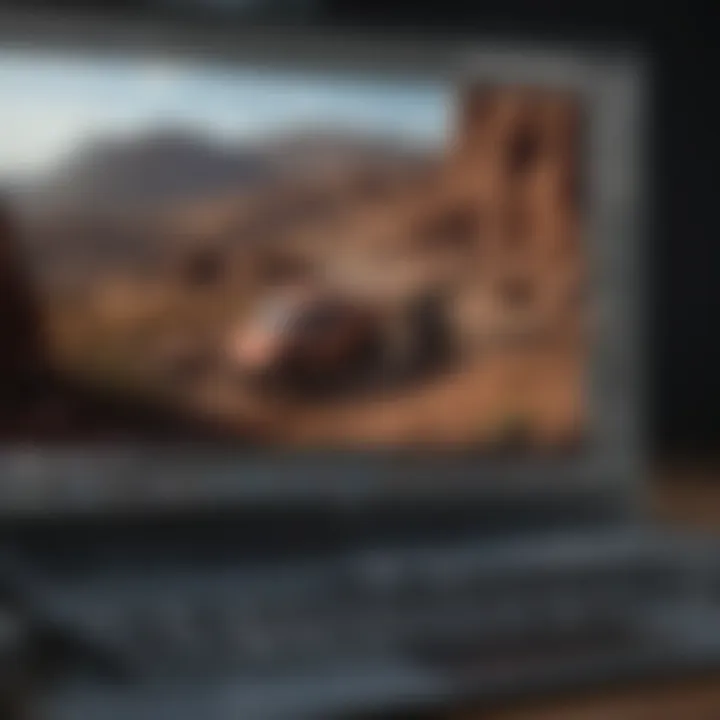Mastering Photoshop: A Beginner's Comprehensive Guide


Intro
Adobe Photoshop stands as a cornerstone in the digital creative industry, favored by professionals and amateurs alike. Understanding its tools and functionalities can seem daunting for beginners. This guide aims to demystify how to use Photoshop, providing step-by-step instructions, detailed insights, and practical resources. The ambition is to cultivate confidence, empowering users, whether they are enhancing images or designing complex graphics.
Every component covered will be anchored in the needs of newbies who seek a stronger grasp of digital design capabilities. Expectations about what one can achieve in Photoshop will be detailed alongside practical knowledge. Learning to navigate its myriad features offers not just a technical skill but a means of expression for creativity.
Setting Financial Goals
While the focus here is on mastering Photoshop, understanding the intentionality behind skill acquisition also matters. One should set clear objectives about what you hope to achieve, whether it’s creating stunning artwork or enhancing photographs.
Importance of Setting Goals
Establishing goals gives your journey purpose, encourages consistent practice, and builds a strong foundation. Specific milestones could include completing tutorial projects or incorporating distinct tools into your workflow effectively.
How to Establish Realistic Objectives
Setting realistic objectives involves introspection. Ask yourself “What are my end goals with Photoshop?” Align these with your skills, timelines, and available resources. Adjust these Based on personal insights about your learning curve and interests.
Tracking Progress and Adjusting Goals
Through regular self-assessment, like reviewing completed projects or daily exercises, you can observe improvements. If the goals prove too ambitious, it’s crucial to pivot, allowing for achievable objectives to maintain morale and motivation.
Understanding Photoshop's Interface
Familiarity with the layout is a communist must for any user. Photoshop's workspace involves panels, toolbars, and menus tailored to fit multiple designing tasks. You will able to customize this layout as per your most commonly used tasks.
Key Components of the Interface
- Menu Bar: Provides access to all of Photoshop's aspects.
- Toolbox: Contains primary tools needed for editing and designing.
- Panels: Use panels like Layers and Color to manage elements visually.
The setup enables a personalized experience as creativity is individual. Begin by exploring and adjusting to what aids your productivity and comfort.
Regularly refreshing your understanding of basic tools, shortcuts, or features is invaluable.
Essential Tools and Techniques
Photoshop presents a broad spectrum of tools. Each serves distinct functions, yet together they form the arsenal for impactful digital composition.
Basic Tools Overview
- Brush Tool: Fundamental for drawing or erasing.
- Selection Tools: Vital for isolating parts of the image - namely the Lasso and Marquee tools.
- Text Tool: Incorporates typography effectively in designs.
Working through exercises on these tools brings understanding into context rather than pure following. Balancing practical application with theoretical knowledge enhances mastery.
Utilize Tutorials and Resources
Effective learning often lies in external resources. Multiple websites, classes, and forums offer vast knowledge, enhancing the learning experience. Reddit forums and platforms famous such as YouTube can support this educational journey dramatically.
Recommended Learning Resources
- Adobe’s Official Tutorials: Comprehensive and often kept up-to-date.
- YouTube Channels: Search for expert-led tutorials specific to tools or objectives.
- Communities: Engage in discussions on platforms like reddit.com where users share insights and answer questions.
- Link: Adobe
Exploring these additional resources are beneficial as they introduce diverse styles and techniques not necessarily found in textbooks.
Prelims to Photoshop
Understanding Photoshop marks the beginning of a pivotal journey into the realm of digital artistry. This section delves into the significance of learning this software, examining its capabilities, features, and its profound influence on various creative sectors.
What is Photoshop?
Adobe Photoshop is a powerful graphic editing software primarily used for photo editing and raster graphics design. Introduced in 1988, Photoshop has evolved into the industry standard for image manipulation. This versatile program allows users to modify images, create intricate designs, and produce captivating visual art. Unlike some simpler graphic editing tools, Photoshop offers a complex array of features such as layer functionality, masks, and adjustment tools, enabling detailed control over every element within a project.
Photoshop caters to different user needs—be it enhancing photographs or designing striking illustrations. The options within Photoshop often seem limitless, yet the user interface is designed in a way that facilitates a learning curve for beginners. Each feature, from basic tools to advanced techniques, reveals layers of potential that can enhance the quality and creativity of digital projects.
The Importance of Learning Photoshop
Cultivating proficiency in Photoshop not only strengthens creative skills but opens numerous professional opportunities across various industries.
- Creative Expression: Mastery of this tool empowers individuals to articulate ideas vividly through digital art.
- Career Enhancement: Many job markets now demand basic to advanced skills in Photoshop. This proficiency can provide a competitive edge in fields like photography, graphic design, marketing, and web development.
- Versatility: Whether one is interested in image retouching, digital painting, or creating sharp vector graphics, Photoshop provides the tools necessary for all forms of visual creation.
- Collaboration: In many creative environments, Photoshop serves as a common platform for collaboration among artists and designers. Understanding how to use it enhances communication and productivity in group projects.
However, the journey to mastering Photoshop can seem daunting. Don’t be intimidated. With the right guidance and commitment, anyone can unveil the extraordinary potential of this tool. Remember, every expert was once a beginner.
Installation and Setup
Installing and setting up Adobe Photoshop is a crucial first step in harnessing its capabilities. Understanding the needs of your computer and the software itself can eliminate potential issues later in usage. A proper setup ensures that the software runs smoothly and operates efficiently, which is vital since Photoshop can be resource-intensive. Bringig all these factors into cconsidertaion guarantees that users spend less time troubleshooting and more time focusing on their creative projects.
System Requirements
Every program has specific system minimums and recommended specifications, and Photoshop is no exception. Familiarizing yourself with these requirements in advance can save you considerable time and frustration.
As of October 2023, here are the frequently listed system requirements for Adobe Photoshop:


- Operating System: Windows 10 (64-bit) or macOS Monterey and later
- Processor: Intel or AMD processor with 64-bit support; 2 GHz or faster
- RAM: Minimum of 8 GB (16 GB recommended)
- GPU: GPU with DirectX 12 support and 2 GB (4 GB for 4K displays) of GPU memory
- HDD: Additional space for installation; SSD is preferred for better performance
- Display: 1280 x 800 display with 100% UI scaling
- Internet: Internet connection is essential for cloud features, subscription features, and activation
These specifications aim to provide optimized performance. Before installation, ensur you verify your system can handle the demands of Photoshop. Therefore a quick check of your system's specs undersettings will suffice.
Downloading and Installing Photoshop
The process to download and install Photoshop involves a few logical steps that simplify the experience. This ensures all files needed are intact before you can start creating your projects. Here’s a structured way to do this:
- Go to the Adobe website » Navigate to the official Adobe site. If you do not have an account, create one first.
- Select Photoshop » Find your way to Photoshop's product page, where you will have options for different subscriptions.
- Choose a Plan » Pick from individual plans, photographer plans, or any that fit your need best.
- Download » After choosing, click download. This should start automatically.
- Installation » Once the file is downloaded, run the installer. Follow on-screen instructions to finish installation. It is simple yet straightforward.
Refer to Adobe's installation guide for any specific queries.
Setting Up Preferences
After installation, you might think that you are all set. In reality, configuring Photoshop settings according to your workflow can greatly enhance your editing experience. Familiarity with preferences allows smoother operations and customizes the interface.
To adjust preferences:
- Launch Photoshop » Open the program on your computer.
- Access Preferences » Navigate to
Navigating the Interface
Navigating the Photoshop interface is crucial for anyone who aims to utilize its powerful features effectively. A smooth understanding of the interface allows users to access tools and functions quickly, which enhances the creative process. In essence, knowing where to find the necessary components saves time and amplifies productivity.
Understanding the Toolbar
The toolbar in Photoshop is one of the most prominent elements. It contains essential tools for various tasks. The tools range from selection and editing to coloring and painting tools. Familiarizing yourself with the toolbar helps in streamlining workflows.
Each tool has different functions; for example, using the Rectangular Marquee Tool enables users to select specific areas of an image easily. Users can easily switch between tools by pressing the corresponding keyboard shortcut. Learning to navigate these tools is a foundational skill in Photoshop.
Key tools included in the toolbar are:
- Selection Tools: These are paramount for isolating sections of your image.
- Editing Tools: These facilitate adjustments and transformations.
- Brush and Precision: These help in creative portions like painting and designing text.
The toolbar might also be customizable. Users can arrange it according to their preferences, making it even more suited to personal workflows.
Exploring the Menu Bar
The menu bar sits at the top of the screen and lists various options organized by category. It acts as a centralized hub to access Photoshop's multitude of features. Within the menu bar, you find sections like File, Edit, Image, Layer, Type, Select, Filter, View, Window, and Help.
Each section contains sub-options that lead to specific functions:
- File: Place creator tools for new projects and saving.
- Edit: Involves undos/undos multiple operations related to your edits.
- Layer: Where you manage layers. It’s essential for more complicated projects.
One critical aspect to consider is keyboard shortcuts applied through the menu. Efficient usage of shortcuts can greatly improve editing speed and efficiency. Having a mental note of frequently used commands prevents disrupting the creative flow.
Using Panels and Workspaces
Panels in Photoshop hold various tools, adjustments, and information that further aid editing, understanding, and organizing layers. They typically sit on the sides of the interface and can be expanded or hidden. Workspaces play a vital role as well; they dictate the set of options in front of you based on your current task—be it editing photos or designing layouts.
Each workspace is tailored for specifics:
- Essentials: Ideal for most basic functions and easy usage.
- Photography: Focused on controls relevant for photographic editing.
- Painting: Designed specifically to cater artists who engage in extensive painting tasks.
Panels can often be customized—add or remove tabs asYour needs change. Remember, can Save individual configurations suited to specific projects. Managing Panels instead of overwhelming yourself aids in better organization, which results in professional output.
Understanding the interface is vital because it encourages streamlined processes. Familiarization elevates your potential in leveraging the power of Photoshop efficiently.
Core Tools and Features
Core tools and features of Adobe Photoshop are the foundation on which users create and modify images. Understanding these tools enhances efficiency and facilitates creativity. Each tool serves its purpose, allowing for more intricate work than mere basic editing. Mastering these elements means unlocking the true potential of Photoshop. This section explores key tools such as selection tools, brushes, text tools, layers, and adjustment layers.
Selection Tools
Selection tools allow users to specify portions of an image for editing. They are crucial for detailed modifications. The marquee tool selects geometric areas of an image. The lasso tool permits freeform selections. Lastly, the magic wand tool selects based on color similarity. Each of these tools serves a unique function and enhances editing precision.
- Benefits of Using Selection Tools:
- Provides ability to isolate areas for targeted adjustments.
- Enables the application of effects only where needed.
- Facilitates intricate edits that enhance overall composition.
Brush and Pencil Tools
The brush and pencil tools in Photoshop are essential for freehand drawing and painting. Adobe provides a variety of brushes, ranging from standard causing tools to specialized ones designed for specific styles or tasks. These tools can have adjustable size and texture. Users can create stunning illustrations and designs with these versatile instruments.
- Features of Brush Tools:
- Custom patterns and color blending options.
- Dynamic modelling for realistic effects.
- Pressure sensitivity for nuanced strokes, especially for graphic tablets.
Text and Type Tools
Text and type tools are pivotal for adding text to images. These tools facilitate basic typography adjustments such as font selection, size, and color changes. More advanced features allow for text formatting and manipulation, growing design possibilities. Users must grasp how to make text that fits the image’s theme or message.
- Important Aspects of Text Tools:


- Layering text allows for multi-dimensional designs.
- Various effects can increase text visibility, from shadows to outlines.
Layer Functions
Layer functions are intrinsic to Photoshop’s design concept. Every adjustment using the layers is non-destructive, meaning that the original image remains unaltered. Essentially, they function like transparent sheets placed on top of one another. Each layer can be independently modified, providing the flexibility for complex compositions. Understanding how to manipulate layers is vital for effective editing.
- Key Points About Layer Functions:
- They allow for organization and compartmentalization of edits.
- Layer styles applied can enhance attributes without permanent alterations.
- Masks can further refine specific edits.
Adjustment Layers
Adjustment layers allow users to apply enhancements without actually changing pixel content in an image. Popular types include brightness/contrast, color balance, and hue/saturation adjustments. This feature enables users to experiment significantly without fear of losing original work. Adjustment layers modify the layers beneath without permanently affecting them.
- Usage of Adjustment Layers:
- Makes edits easily reversible — perfect for experimentation.
- Can target selective layers without altering another.
Mastering core tools transforms the approach toward photo editing, allowing creative expression to thrive while maintaining fundamental control over every aspect of the process.
Basic Editing Techniques
Basic editing techniques form the foundation for effective Photoshop use. These skills are essential for anyone looking to enhance images. Mastering these methods is crucial for achieving desirable outcomes in creative projects. Knowledge in this area can transform raw images into professional-quality visuals, making it essential for photographers, graphic designers, and hobbyists alike.
A fundamental part of image editing involves adjusting compositions through cropping and resizing. It allows users to focus on significant elements while discarding excess areas that distract from the main subjects. Incorporating color correction methods fine-tunes the general look, ensuring accurate representation of subjects' hues and tones. Filters contribute an extra layer of visual flair, helping to change the atmosphere or style of an image instantly.
Cropping and Resizing Images
Cropping and resizing images serves as one of the basic yet vital editing techniques. Photoshop provides tools that simplify this process. You can modify dimensions and remove unnecessary parts from photographs. This simplifies the composition of images, allowing you to concentrate on significant areas or subjects.
The crop tool is perhaps the most important. Simply select the area of the photograph you wish to keep. By dragging corners or edges, you can define the perfect composition without losing the original image. On the other hand, resizing allows you to alter the dimensions without compromising the image quality. Pay attention to maintain the right aspect ratio to prevent distortion. Proper execution of cropping and resizing leads to a more polished final creation.
Color Correction Methods
Color correction holds paramount importance in photography, affecting how an audience perceives an image. Photoshop has a variety of tools function specifically for correcting colors. These tools help in adjusting brightness, contrast, saturation, and overall color balance.
Methods like Levels and Curves allow users to make significant adjustments easily. Levels adjust the shadows, midtones, and highlights, while curves give you flexible control over color changes across various tones. Learning how to use these effectively can yield remarkable results that breathe new life into images.
Additionally, always consider the purpose of color correction. Is the aim to showcase realism? Or perhaps to evoke a specific emotion? This intention will guide where adjustments should be made and the extent to which they are applied.
Using Filters Effectively
Filters are powerful tools for modifying the visual outcome of an image. Photoshop's filter gallery offers a wide variety. Users can apply different effects to enhance creativity. From blurring to sharpening, filters influence the depth and dimension of an image.
You should explore the various filters to understand their respective impacts. Experimenting with these can lead to discovering unique outcomes. It is wise to remember moderation when using filters. Excessive applications can obscure details, leaving onlookers confused about the intended focus.
In sum, mastering basic editing techniques equips you with the skills to convert ordinary images into visual masterpieces. Implementing cropping, resizing, color correction, and appropriate filter applications is fundamental in this process. Embracing these techniques not only conveys professionalism but also elevates your entire creative portfolio.
"Master the basics, and you can experiment beyond the boundaries of common editing practices."
For additional guidance on photography and editing techniques, you can explore resources like Wikipedia, Britannica, Reddit, and Facebook for community tips and shared experiences.
Advanced Techniques
Advanced techniques in Photoshop are crucial for individuals who want to elevate their creative flair. This section discusses the more intricate features offered by Photoshop that can help users refine their skill sets and enable professional-level edits. Mastery of these techniques not only enhances artistic expression but also increases efficiency. Understanding concepts like composite images, masks, and smart objects greatly expand a beginner's toolbox.
Creating Composite Images
Creating composite images is one of the core advanced techniques in Photoshop. It involves blending several images into one cohesive visual. This is useful for graphic designers, photographers, or anyone looking to create unique visuals for their projects. The process allows you to combine elements from different sources, thereby enhancing creativity
There are a few key steps involved in this technique:
- Source Your Images: Begin by selecting the images you wish to combine. Ensure they are all in high resolution to maintain quality.
- Layer Management: In your Photoshop workspace, import each image as a new layer. Working with layers enables you to make adjustments without damaging the original images.
- Selection Tools: Use selection tools to choose parts of images that will be useful and perform careful adjustments using layers.
- Blending: Employ blending techniques to harmonize colors and textures from different sources for a more natural result.
- Final Adjustments: Once satisfied, you can do final tweaks such as color correction or adding shadows to enhance depth and realism.
Understanding and Using Masks
Masks in Photoshop are vital for advanced editing techniques. They allow users to hide or reveal portions of layers with high precision.
There are several advantages to using masks:
- Finesse: You can make non-destructive edits. Instead of erasing part of an image, a mask can be applied to obscure certain areas, allowing you to revert any changes easily.
- Flexibility: Masks can be edited afterward, providing adaptability when you reconsider how an image should appear.
- Precision: Masks let you control which parts of a layer are affected by adjustments. You can precisely select small sections of the image while safeguarding others.
To use a mask, you would utilize the following steps:
- Add a Mask to a Layer: Click on the mask icon in the layers panel to create a new mask.
- Brush Tool: The Brush Tool will be your instrument for painting black or white onto the mask. Black hides the layer while white reveals it.
- Fine-Tune the Edits: By switching between the colors, you can modify what is visible. Zoom in and work carefully for the most detailed areas of your project.
Working with Smart Objects
Smart Objects are a significant feature for bearers of advanced techniques in Photoshop. They allow the user to manipulate images in a non-destructive manner, preserving the original image data and quality, even after edits.
The benefits include:
- Editing After Transformation: Once you define a layer as a Smart Object, you can scale, rotate, or warp it without losing quality or altering the original properties.
- Applying Filters Non-Destructively: Filters can be applied and changed anytime, creating a layer that preserves the original photo's sharpness and detail.
- Batch Processing: If working on multiple images, you can apply the same transformations readily across various files using Smart Objects.


To leverage Smart Objects:
- Convert Layer to Smart Object: Simply right-click on the layer you want to convert and choose “Convert to Smart Object.”
- Edit the Contents: You can double-click the Smart Object's thumbnail to open it in a separate tab for more targeted edits.
- **Apply Effects and Filters:**All adjustments made will be non-destructive unless rasterized again.
In summary, mastering advanced techniques in Photoshop constitutes an invaluable asset for creatives who aim to take their work to the next level. By understanding composite images, utilizing masks, and working with smart objects, users gain the ability to create visually striking compositions, coupled with various editing efficiencies. This enhanced skill set can differentiate them in a competitive landscape.
Exporting and Saving Projects
Exporting and saving projects in Photoshop is a crucial step that influences how your work is utilized and shared. Understanding the different ways to save your work improves workflow, collaboration, and the quality of final outputs. It allows users to safeguard their projects effectively, ensuring that their creativity is well-preserved across various mediums.
Understanding File Formats
Various file formats serve different purposes in Photoshop. Each format carries its own specifications and impact on quality and compatibility. Knowing which file format to choose based on your end goal is a fundamental skill.
- PSD (Photoshop Document): This is the default file type for saving Photoshop projects. It retains all layers, adjustments, and paths, allowing users to continue editing the project without losing valuable information.
- JPEG: Ideal for photographs displayed online, this format significantly compresses file size, making it easy to share. However, it does not support transparency and is not suitable for images requiring further editing.
- PNG: Great for web graphics, this format supports transparency and is useful for screenshots and images without a background.
- TIFF: Recommended for high-quality images, TIFF is often used in professional printing. It supports layers and multiple channels but results in larger file sizes.
- GIF: Primarily used for web graphics with simple animations, GIF does not support high color depths and is limited to 256 colors.
Choosing the correct file format depends on your project’s end use, balancing quality image with the file’s size and performance.
Exporting for Web and Print
Exporting an image for web or print involves distinct requirements. For web usage, the focus is speed and visual appeal, while print places value on superior quality.
Web exports include:
- Optimized JPEGs for photographs selected for quick loading.
- Smaller PNG formats for graphics requiring transparency.
Print exports might consider:
- High-resolution TIFF files that maintain detail.
- Vector-based formats, for logos, which scale without losing quality.
Both processes require striking a balance between file size and quality. Photoshop provides tools to optimize images, adjust color profiles, and fine-tune settings tailored to specific needs. After adjustments are made, use the “Export As” option, giving you control over image dimensions, quality, and format to achieve the desired results.
Saving PSD vs.
Other Formats
The PSD format is unique because, unlike other file types, it preserves all project elements intact. Below are the key differences to consider when deciding whether to use PSD or alternative formats:
- Editing Capabilities: PSDs retain all layers, effects, and adjustments, allowing extensive editing over time. Conversely, formats like JPEG flatten all layers, making further adjustments impossible.
- File Size: PSD files tend to be larger. Other formats, such as JPEG and PNG, offer much smaller file sizes, suitable when storage space and sharing are a consideration.
- Compatibility: While PSDs are universally embraced in the Adobe suite, other formats may perform better with specific applications or online platforms.
Using PDF files can also bridge between maintaining format and accessibility. They are viewable on most devices while preserving high-quality visuals.
Choosing a saving method fundamentally reflects the specific use case. It’s important not merely to pick stationary options, but to align decisions closely to the output requirements, whether they focus on print, web, or local editing needs.
Resources for Learning Photoshop
Accessing the right resources is crucial for anyone looking to master Photoshop. The tools available in the software can be complex, and learning them requires guidance. This section outlines various types of resources that students can utilize. By engaging with these materials, individuals can enhance their knowledge and skills effectively. Tailored solutions exist for all learning styles and levels, allowing users to find the most suitable options. Resources can also encourage adept creativity and critical thinking.
Online Courses and Tutorials
Numerous platforms offer online courses focused on Photoshop. Websites like Udemy and Coursera provide lessons that cover a broad range of topics from the basic functions of the toolbar to advanced image editing techniques. Online resources often have video tutorials, which can show real-time application of tools. This feature enables students to gain practical insights into their functions. For instance:
- Many tutorials are designed for various skill levels, making it easy to start with basic skills and progressively tackle complex tasks.
- Small projects within courses provide opportunities for hands-on practice, which reinforces learning.
- Some courses even offer certification, adding value to the time spent learning.
Each course could offer feedback and support, encouraging a sense of community learning. THe interactive aspect makes this easily the most favorable option for many.
Books and Printed Resources
Books continue to play an important role in learning Photoshop. Guides by industry experts delve into tool functionalities and provide exercises. They often have illustrations that help clarify complex processes and terminology. Using printed resources gives learners something tangible, allowing them the option to work offline. Many recommend well-known titles such as "Adobe Photoshop Classroom in a Book". Reasons to consider books include:
- DIned information provides easy reference.
- They allow learners to absorb material at their pwn pace.
- Printed layouts often contain clear visuals without the distraction of screens.
A great approach is to use a combination of both online materials and printed books for comprehensive learning.
Community Forums and Support Groups
Engaging with others who share similar goals can enhance the learning experience. Community forums such as those on Reddit or support groups on Facebook provide platforms for discussion. These settings offer a place where learners can pose questions, share tips, and seek help on problematic areas. A few noteworthy points about this learning avenue are:
- Connecting with veterans and other learners greatly enriches predetermined knowledge.
- Discussions can bring new perspectives, enhancing problem-solving ability.
- Community support often leads to the formation of lasting friendships that extend beyond professional networks.
In summary, blending various resources maximizes the potential to learn Photoshop effectively. With the rise of various platforms and community involvement, one can continuously refine their skills.
The End
The conclusion serves as a vital component of this article. It encapsulates the essence of learning Adobe Photoshop and reinforces the information provided in earlier sections. Understanding key takeaways allows beginners to build a strong foundation of knowledge.
Recap of Key Points
In this discussion, we delved into the following areas:
- Introductory Concepts: We defined what Photoshop is and its significant role in creative fields.
- Installation Details: Interested users can only leverage Photoshop's capabilities after verifying system requirements and successfully installing the software.
- Interface Mastery: Navigating the toolbar, menu bar, and panels is essential for efficient use of this program.
- Tools & Features: We discussed crucial tools such as selection and brush tools, as well as features like layers and adjustment layers.
- Basic Techniques: Issues like cropping, resizing, and color correction form the core of photo editing.
- Advanced Techniques: Understanding more complex, creative avenues like composite images and masks open more possibilities.
- Exporting Wisely: Choosing the correct file formats impacts the outcome of sharing and showcasing your work.
- Learning Resources: There are many platforms; online courses, books, and community forums offer a wealth of information.
Encouragement to Practice and Experiment
Practicing and experimenting are vital in mastering any skill, including Photoshop. Don't hesitate to try new filters, explore layers, and test different editing strategies. The toolkit is vast, and the more you engage with it, the more potential you'll unlock. Based on your growing knowledge, consider these steps:
- Take smaller projects and apply new techniques. This incremental approach fosters confidence.
- Join community discussions online to gain insight from other learners and professionals.
- Share your work to receive constructive feedback, as this will help refine your skills.
Engage with the software beyond theoretical knowledge. Just like any other learned skill, Photoshop becomes second nature only through active engagement. Each project is a new opportunity to enhance your craft.



